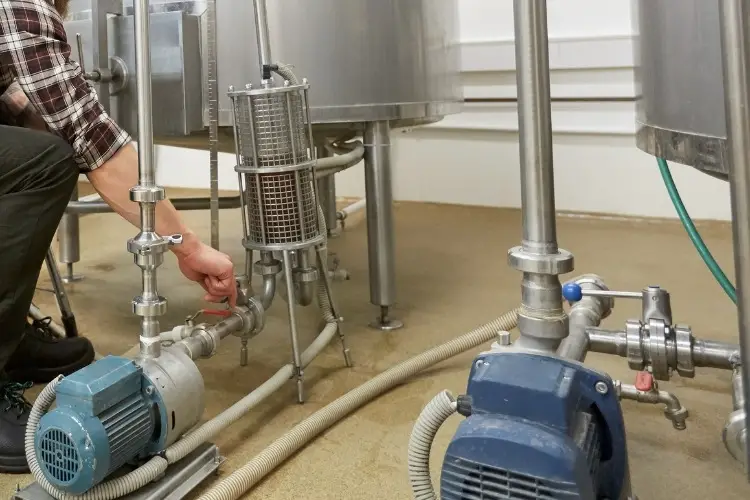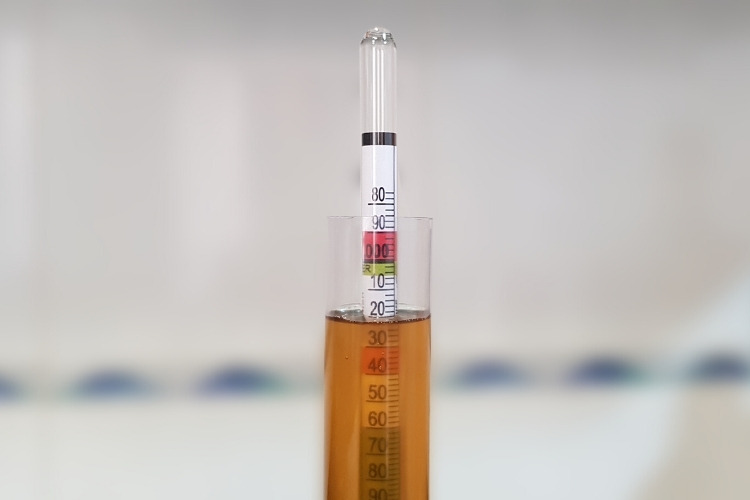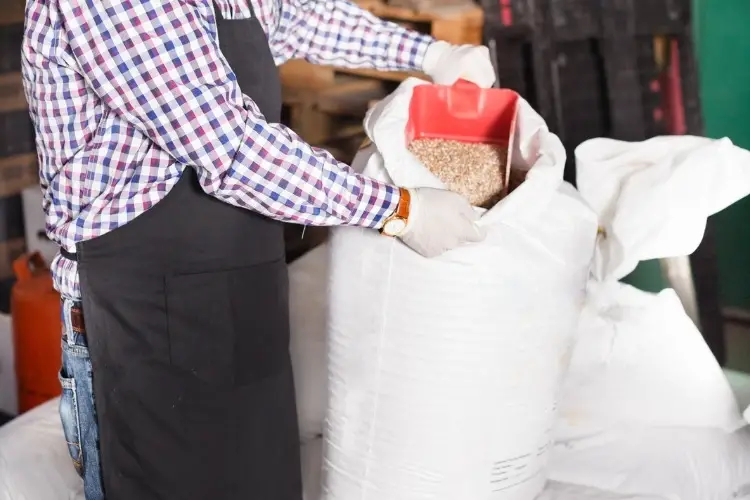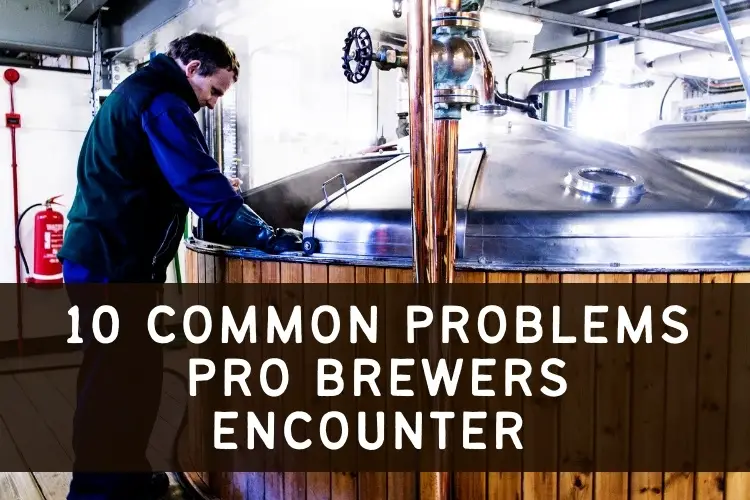The minute one steps into a pro brewery, the feeling is palpably different from the homebrew set-up. Everything is steel, there is a physical plant, creating steam or cooling to sub-zero temperatures. 5 – 30 gallon barrels of noxious and corrosive chemicals inhabit a special corner. It’s wet all the time. Ah, home.
Having spent 10 years in the pro brewing world I’ll discuss the top 10 things that drive us mad, and to sobriety. Sometimes, we get so frustrated, there is no longer any fun in drinking.
We’ll try two methods. First, we’ll answer some longer production-oriented questions and then go for a lightning round with some rapid-fire business-side answers for common daily occurrences. In this way, we’ll cover as much ground as possible.
1) What can I do if my beer fermentation didn’t take off?
Every brewer wants to hear vigorous off-gassing and possible blow-off 12-14 hours after pitching. If not, we begin to worry. 24 hours passes and a brewer fears the worst.
Possible problems are improper temperature and under-pitching.
Improper temperatures
Most American brewers brew ales. If the temperature drops below 58 – 60˚, the yeast will grow sluggish and not respire fast enough to take off. If it cannot multiply and begin to work within 36 hours, the risks of off-flavors and even infection grow dramatically.
Solutions
If it’s too cold, it is hard to do much about it. One trick is to blast near boiling water into another tank to heat it up. Turn the glycol jackets completely off. Gently, transfer the raw beer to the new tank. It may pick up a 2 – 3˚ in this way. It is a long shot.
Underpitching
This is a tough one. The only way you can really know besides suspect is to take a cell count, but many of us don’t have microscopes.
Solutions
If you feel you have underpitched, in a perfect world you have the same (or similar) style of beer in primary fermentation close by. Transfer over a barrel (or 5-10% of volume) and the fermenting beer may kick the beer off.
Adding more yeast may help, but if it was unavailable 2 days ago it’s likely unavailable now. You also will not know the 02 level of the beer so are pitching blind. You could consider yeast nutrient also, but this is an after the fact remedy and its benefits marginal.
If the brewery does not have a lab, I can recommend Alemanni solutions. They offer many quality control product solutions without a lab.
2) What can I do when my pumps are leaking?

Pumps are the workhorses of the brewery.
We transfer beer, especially from the kettle which could take 30-45 minutes.
As beer leaks out of the pump housing, 1 – 5% easily ends up on the floor.
This is a simple solution. Have gasket kits handy and ready to go. Make this the last brew with wasted wort.
A kit consists of a large rubber housing gasket, a carbon ring, a spring, and a screw or two.
3) I came in Monday morning and my temps had spiked. Will I lose the beer?
You arrive in the brewhouse either overnight or from the weekend and all the beers are at room temp. The fermenting ones have spiked to 78˚F.
A common problem during the summer and to be expected.
Equipment malfunction
We cannot control this, and it will happen.
The best solution is redundancy. This means have spare parts and equipment of the most vital functions.
Temperature controllers will break. There will be a heatwave and the glycol chiller will shut off on a Saturday night and the beer will spike in temperature until Monday morning.
Come in Monday, isolate the problem, correct it and hope for the best. If your processes are clean, the beer may withstand the temperature spike.
4) My filter is stuck, how can I unstick it?
My three brewhouses all had plate and frame filters, two of them undersized.
Here is the typical scenario with filtration. After 20 m. the beer flow has slowed to a crawl.
Two possible problems face:
- The beer could warm up, risking diacetyl coming to the front.
- The beer picks up O2.
- This will happen to pub brewers and busy packagers as well. They will crash the beer temp immediately after fermentation, putting the yeast to rest and halting fermentation and/ or attenuation. If the beer has not had a proper diacetyl rest, this buttery, candy-like flavor will come out if the beer warms up.
- Plate and frames are primitive and while functional and cheap, they will allow for O2 to creep into the beer. There are likely about one dozen junctions and seals it could slip in.
Step by Step Solution
- On the outlet of your filter, you have a T-Intersection and a valve. Filters are usually sanitized with heat. Having cleaned it, run 170˚ water through it for 10 minutes. Hook up the beer and let the tank just push the water out. You drain it out through this T.
Often, the filter gets clogged up with yeast, it is just the nature of the beast. You can stand there for 3 hours filtering your 10bbls. of beer (all the while beer is dripping onto the floor from the paper plates), or you can wash it out. - Also, install a T-Section to the inlet of the filter. Close both beer tanks, attach a water source (with a sanitary fitting) to the outlet side T, open the inlet side T and blow water back through the filter.
It is not pretty, it loses beer, and it may keep you from spending half the day watching a stuck filter. - One more tip. Before flushing out the yeast, the filter will be filled with beer. On the inlet T, also have a quick connect gas fitting. Close the inlet beer valve and blow CO2 into the filter. Most of the beer in the filter will be pushed into the brite tank. Put your ear against the tank and listen for bubbling to know it’s done.
For a source of filters, brewhouse pumps, or any brewery needs, please contact KMB Consulting. We have partnered with Applied Beverage Tanks Inc.
With 30 years of industry experience, ABT supplies breweries and distilleries worldwide – in over 30 States and 13 countries. With every single one of their clients as a reference, their work speaks volumes.
I began my relationship with Jim and Alan (of ABT) in 1999. KMBC is a direct line to their desks. Or feel free to call them. I assure you the prices will be exactly the same.
Please share the customer code, Jonas@KMB, to facilitate communication.
5) Why has my fermentation stopped and gravity is still high?

Things go well for 3-4 days, a week maybe, and then nothing. Test the gravity of the beer and it is stuck at 1.020.
It happens to everyone. We are not sure exactly why it happened: high mash temperature, overused yeast, but the FG is simply too high.
Solutions
- One solution is already mentioned above. Use about 5-10% of the same or similar beer in high krausen and pump it in. It may jumpstart the beer and get it working again.
- Another option is to add yeast nutrient and circulate the beer trying to rouse flocculated yeast. Yeast nutrient is an enzyme mix best used before fermentation. However, in conjunction with a good circulation, it may help.
- Finally, if the flavor is OK, and there is no perceived infection, it may be blended out. Brew the same beer with a lower mash temp, so it will finish dryer. Let it ferment out, and then blend them. The first beer finished at 1.020, the second at 1.010, they blend down to 1.015.
6) What can I do if the beer is cloudy, even when I fined and/ or filtered it
I ran it through the filter. I crash-cooled it. It is still cloudy, no matter what I do.
Solutions
- The most benign problem is protein haze, also known as chill haze. This will form in the glass and is due to a pH imbalance in the mash. It usually will not affect the flavor. If pub-draft beer, it likely will not matter anyway. In this case, watch your sparge temperature and check the pH of your sparge water.
- A more insidious culprit is yeast autolysis. You perhaps can fine it out with isinglass or gelatin. Nothing short of a sterile filter plate will clean it visually from the beer. You are left with so many off-flavors: tart, fruity, bitterness, to a citrus bouquet in the worst way.
Two wretched by-products are Isoamyl Acetate (bananas) and caprylic acid (goaty, lunch-meaty). Both occur under stressed yeast conditions though the isoamyl can form during excessively hot fermentations. Unfortunately, once these flavors set in, it’s hard to get them out. Sometimes you need to know when to cut your losses.
Keep your yeast fresh and add plenty of O2 when cooling and pitching.
7) How can we deal with low sales?
We will deal with the wholesale aspect here. In a low-saturation market, it’s easy. Get out the door, shake hands and build relationships with each outlet you can, whether bar or package store.
Building relationships will garner goodwill and loyalty.
In a hyper-competitive market. The same rules still apply. Relationships are still vital. However, there is more of an issue of price and promotion.
Social Media and feet on the street will come into play.
8) I messed up my inventory and it’s brew day, what can I do?

Relationships. Get on the phone with your buddy across town.
–Do you have 20lbs. of Chocolate malt
-Can I borrow 5 pounds of gypsum?
-My chiller is low, do you have 10 gallons of glycol to spare?
-UGHHH, I need 5 lbs. of Saaz hops in 2 hours, my sparge is almost done!
Business can be ugly and competitive. In my experience, brewers take care of one another. Rely on your friends and compassionate rivals in the market.
9) My supplier gives me problems, what now?
If they cause you grief, get a new one. There are dozens if not hundreds of people ready to serve you.
If it’s your problem: for example you need Net 30 credit on pallets of malt. You are a small newer operation and haven’t sufficient credit. Call your malt supplier for example:
–Listen Kris, I need Net 30, can you help me.
-Jonas, you have no track record.
-It will really help us with cash flow getting started. You try persuasion.
–OK, pay your malt bill on time for 90 days, I’ll give you Net 30.
True story. And a couple of times I did have cash problems. I called Kris, let her know, and explained exactly how and when I would catch up. The malt flowed. Relationships.
10) Employee issues
This is hard. Be 100% honest and direct. Also recognize that your problems are not theirs, and vice versa.
Be crystal clear on the job role and your expectations, in writing. Lastly, they appreciate the little things.
At Christmas or July 4th, even if cash is tight, kick them $50-100 as a bonus, or give them a dinner/ hotel voucher. The small things make all the difference.
Summing up
These challenges above are but a snapshot of what you will face on any given day, week, or month. Be flexible, plan for breakdown, and anticipate 2 steps ahead.
KMB Consulting can assist you in all of your challenges, large or small. Brewers need support and input. It is an artisanal craft, refined by years in the brewhouse. It is also a uncommonly specialized business.
Interested in a start-up or expansion? From conception to construction and pilot brews, we have the experience.
Today’s brewers have puzzles that need a fresh perspective. I’ve walked in your shoes. I know the victories and struggles that come with the brewer’s life. Check out our Pro Brewing Consulting Service and reach out to us. No problem is unfixable.

